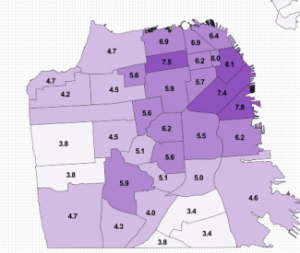
Looking for an apartment to rent in San Francisco?
Brace yourself.
Last year, the City by the Bay earned the dubious distinction of having America's most expensive rental market, beating out longtime heavyweight New York. Due in part to the surge in the region's tech-fueled jobs market (some "friend" indeed, Zuckerberg!) and the city's longstanding shortage of affordable housing units, the spike has led to jaw-dropping rents, with the median monthly rate of a mere studio at more than $2,200 a month, according to apartmentlist.com.
So for those of us not bringing in the 7-figure paychecks, how rough have things actually gotten out there? The interactive map below, produced by the San Francisco Department of Public Health and designed by Stephanie May, shows a housing affordability gap that may just send you packing.
According to the data, it takes earnings from more than five minimum wage jobs to afford the rent in a two-bedroom apartment in neighborhoods like the Mission and Potrero Hill, and more than seven minimum wage jobs to afford a similar unit in SoMa and the Financial District.
Using Craigslist rental listing figures from the second-half of 2012, and median income data from the American Community Survey, the map shows just how big the chasm is between median income and fair market rents in different parts of the city, and the number of minimum wage jobs a renter would have to work to be able to afford a two-bedroom apartment at those rent levels. (Fair market rent is the price to which 40 percent of listings are less than or equal in a given neighborhood.)